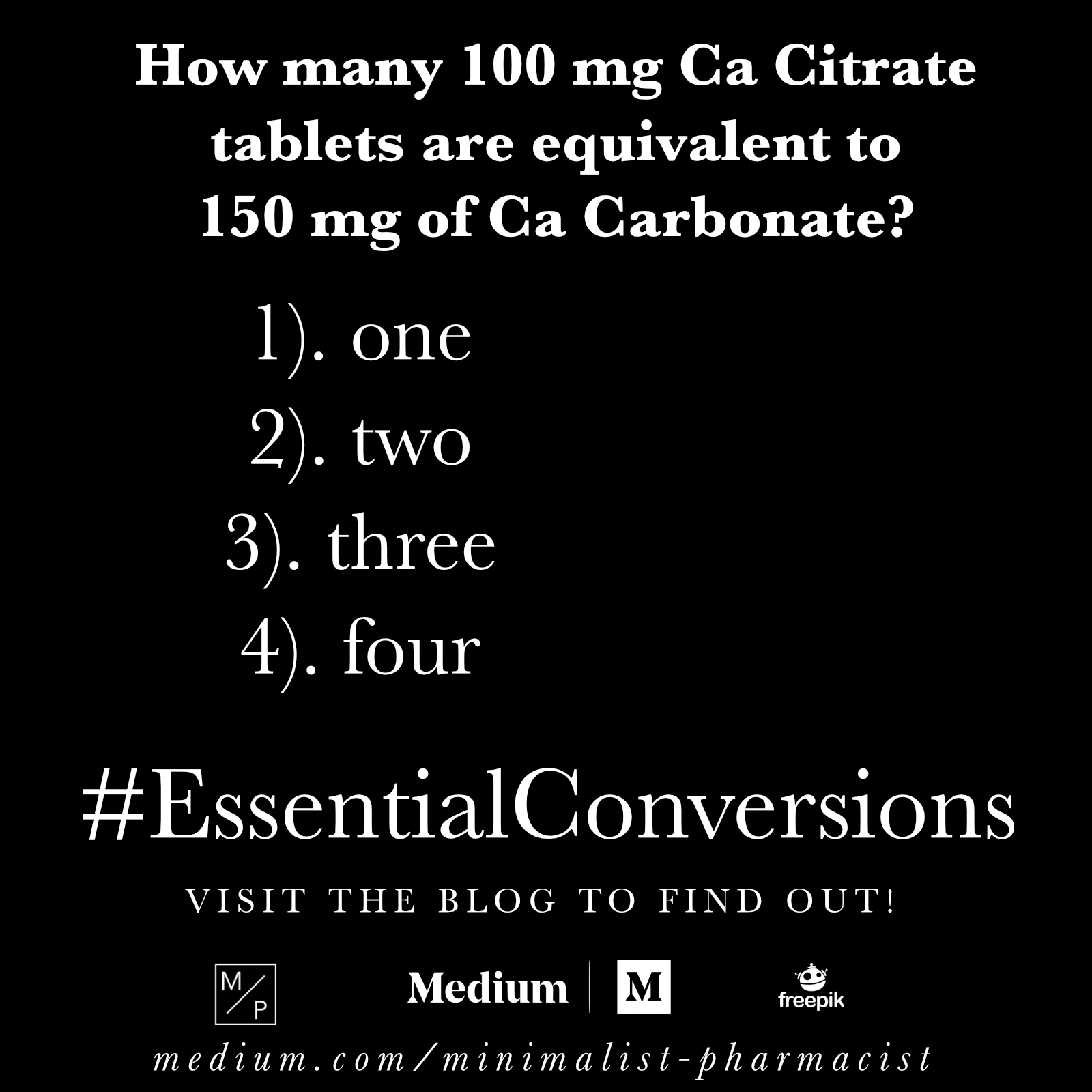A comprehensive look at all the conversions you need to memorize.
 Clotaire Lehoux
Clotaire Lehoux
Overview
Being able to do pharmaceutical calculations is an absolute must for the NAPLEX. In fact, if you can?t do the math, you won?t pass. Period. Having plenty of practice and being comfortable with all conversions will help you be more prepared to handle any calculation problem given to you on the NAPLEX.
The truth is, due to the unpredictability of the NAPLEX, you may end up with very simple and straightforward calculations or get questions that are straight out of a horror film. The point is, be prepared, practice well, and know these conversions by heart. Let?s do this.
Volume Conversions
- 1 teaspoon = 5 mL
- 1 tablespoon = 15 mL
- 1 fluid ounce = 30 mL
- 1 cup (8 fluid ounce) = 236.5 mL
- 1 pint (16 fluid ounce) = 473 mL
- 1 quart (2 pints) = 946 mL
- 1 gallon (4 quarts) = 3785 mL
The approach I made when learning these ?liquid? conversions is to start from the top and build on each conversion. Notice how I listed 1 teaspoon first? In general, the conversions typically double as you are going down the list. Another note to remember is that tsp (teaspoons) is often confused by tbsp (tablespoon). Don?t make this mistake! Note 1 tsp (5 mL) vs. 1 tbsp (15 mL).
Starting with 1 tablespoon (15 mL), double for 1 fl. oz (30 mL). Next, start with 1 c ? 1 p ? 1 q ? 1 g. Memorize cup and double for pint. Then double pint for quart. Lastly, quadruple (multiply by 4) the quart into gallon (which is actually 3784 but close enough). This is how I memorized these conversions.
Weight Conversions
- 1 Grain (Gr) = 65 mg
- 1 ounce = 28.4 g
- 2.2 lbs = 1 kg
Absolutely know 2.2 lbs is = to 1 kg. You use this literally in every calculation. It may be more difficult to remember grain (gr) = 65 mg. It?s an old conversion used back in the day but sometimes pop up every now and then. You should also note not to confuse 1 fluid ounce (liquid) with 1 ounce (weight). In this case, 1 ounce = 28.4 g.
% Volume & % Weight
- % w/v = g/100 mL
- % v/v = mL/100 mL
- % w/w = g/100 g
These calculations have to be mastered. Sometimes, you are just expected to know concentration strength of the most common fluids. For example. NS = 0.9% = 0.9 g/ 100 mL. Or D5W = Dextrose 5% = 5 g/ 100 mL. Remember, the percent stays on the top and either becomes gram (if weight) or milliliter if (liquid). The bottom is always by 100.
Aminophylline (A) to Theophylline (T)
- 5A = 4T
There are other ways to remember this conversion but I found this to be the most efficient way to do it. So basically, I take advantage of dimensional analysis to ensure I never confuse the two.
Example: Convert 100 g of Aminophylline to Theophylline.
100 g A x 4 T / 5 A = 80 g of Theophylline. Notice how the A?s cancel out (one on top and the other on bottom). Leaving you with only the Theophylline.
Specific Gravity
- SG = g/mL
This conversion is much like % volume but instead, there is no %. So in general when you get a specific gravity, it will always be in grams / milliliter.
Example: What is the specific gravity of substance A that weighs 100 g in 200 mL of liquid?
SG = g/mL = 100 g/ 200 mL = 0.5 g/mL
Or if you are just given SG = 1, this means 1 g/mL.
Parts Per Million (PPM)
- % ? PPM (4 decimals to the left)
- % ? PPM (4 decimals to the right)
These conversions can be quite tricky but there is an excellent short cut to remember. First understand the values. When you have parts per million in a %, you basically have this ? 100 (%)/ 1,000,000. So divide the 100 by 1,000,000 and you will see that you lose 2 zeroes and have only 4 zeros left. That is the basis of this shortcut.
Now remember this, when you want to go from % to PPM, I think of Beyonce?s Irreplaceable song (lol, I know). The lyrics remind me to go ?to the left to the left? 4 decimals to get % on the left and to go 4 decimals ?to the right to the right? to get PPM to the right. Lol, I know its crazy but I never forgot it and now, you won?t either.
Parts Per Billion (PPB) ? (7 decimal places)
The same concept applies but instead of 4 decimal places, you move 7.
Ratio
- (100 / %) = 1: X
- (100 / X) = %
These types of questions confuse a lot of people. Like seriously, I was confused when I first had to learn these and they are really not the best way to show a strength of a drug. Regardless, you have to know it.
When you are told to convert to a % into this form ? 1: X, all you will need to do is divide 100 by the % given.
Example: Convert 5% into 1:X form.
[100 / (5/100)] = 1:2,000. Don?t forget to convert the % into decimal form before dividing by 100.
If you need to get a percent, simply do the same exact process but with the number given.
Example: Convert 1:500 into % form
(100/500) = 0.2%. Remember that this means 0.2 g/100 mL. The units much match or the formula won?t work.
Calcium
- Ca Carbonate = 40% Elemental Calcium
- Ca Citrate = 21% Elemental Calcium
Lastly, these type of questions fool even the most prepared because these look super easy but can be really tricky!
Example: You have 150 mg of Calcium carbonate. How many 100 mg tablets of calcium citrate do you need to get same exact dose in elemental calcium?
You?re like, wait what? It?s easy enough to remember that carbonate is 40% elemental calcium vs. citrate being 21%, however, making sense of this conversion has tripped many people. I totally get it, it really is confusing. Here?s how I did it.
Carbonate = 150 mg x .4 = 60 mg of elemental calcium
Citrate = 100 mg/tabs x .21 =21 mg of elemental calcium per tab
60 mg / 21 mg = 2.85 tablets so round up. You need 3 tablets of calcium citrate to get the same 150 mg dose of calcium carbonate. Always convert to elemental calcium on both formulations before determining the tablets. Simple enough?
Excellent Resources
- Pharmaceutical Calculations
- NAPLEX Nuggets
- NAPLEX Practice Question Bank
- Medcharts
- PASS-NAPLEX
- Goodnight Pharmacology
- Dipiro
- Letters to a Young Pharmacist
- Kaplan NAPLEX
- NAPLEX Workbook
- NAPLEX Comprehensive Review
MPJE Resource
- Federal Guide (Reiss & Hall)
Pharmacy Management Resource
- Pharmacy Management (Essentials For All Practice Settings)
Thank You For Reading!
Did you find this post helpful? Perhaps even insightful or game changing? If so, please make sure to support my blog. As a small content curator, I am always looking for ways to provide new content.
Support Minimalist / Pharmacist
Patreon | Paypal | Square
Business
Media Kit | Legal | Contact: [email protected]
Social Media
Instagram | Facebook | Twitter | Tumblr| Google+ | Pinterest | Reddit
Amazon Favorites
Kindle Unlimited | Amazon Fresh | Amazon Music | Amazon Prime | Audible
Prime Student | Fire TV 4K | Amazon Home | Amazon Phones | Car Alexa
Personal Favorites
Spotify | Essential | Bambino | Lunar Tempo 2 | Oblivion | NordVPN
Running Gear
Nike Flex Running Shoes | Nike Element Running Top | Nike Essential Running Pants



